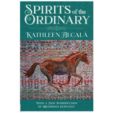I’m grateful to Raven Chronicles Press for bringing this extraordinary historical novel, originally published in 1997, back into print. Set in nineteenth-century Mexico, the book is revelatory and inspiring on many levels. For one thing, it sheds light on the lives and struggles of Mexican Jews, who practiced their religion in secret for fear of persecution. For another, it immerses us in the lives of women who do the opposite of existing in the shadows, as many of their counterparts would have been forced to do at the time.
The plight of Mexican Jews is conveyed largely through the story of Julio Caraval Vargas, who treasures his secret library of religious texts, which were smuggled to safety by thirteen generations of his family. Like other Jews in Mexico at the time of the novel, Julio can practice his faith only in private. In public, he is forced to observe Catholicism in order to hold onto his life and livelihood. Yet in the privacy of his study, Julio delves into his sacred books and engages in the mystical practices of Cabala. Alcalá’s writing about the wonders and mysteries of these practices has a magical quality, and with lyrical prose, she makes clear Julio’s desire to pass his faith on to future generations, despite the potential dangers of these efforts.
Unfortunately for Julio, his son, Zacarías, seems to have little interest in any sort of religious practice, focusing instead on prospecting for silver and gold. (Eventually, this changes dramatically, as discussed later.) Over time, Zacarías’s long absences from home, and his mostly fruitless expenditures on his quest for earthbound riches, alienate him from his wife, Estela. Eventually, she takes charge of matters by restricting Zacarías’s access to her family’s money. More than this, she opens herself up to a relationship that offers her something that had largely been missing from her marriage: sexual gratification. She does so despite judgment from her family and the community at large.
Through the stories of Estela and other characters, Alcalá immerses us in the lives of women who push back against the norms and expectations of the time. Another of these women is Magdalena Hinojosa O’Connell, who was born into poverty and married off–for money–to a cruel spectator. Yet she becomes, in widowhood, a businesswoman to be reckoned with. Another character who defies the conventions of the time is Corey Findlay, an American photographer who disguises herself as a man to follow her dream of photographing people and places in Mexico, a pursuit that might have endangered her had she traveled as a woman. The stories of Estela, Magdalena, and Corey are compelling in and of themselves. Collectively, the portrayals of these characters’ struggles, dreams, and desires suggest that the strength and agency of women–across culture, class, and time–are as eternal as they are undefeatable.
While Estela asserts herself in new ways, her husband, Zacarías, undergoes a transformation of a different sort. After fleeing the guardians of a mine he’d invaded, he is advised by a friend to head north to Casas Grandes, which “holds the thing you seek.” This turns out not to be silver or gold but a spiritual transformation. In Casas Grandes, Zacarías undergoes just such a transformation. He also finds himself sharing stories about the faith of his father, in this way reconnecting with Julio and also forging connections with the local people and their own spiritual beliefs. Zacarías also gains renown as a healer, which authorities believe is drawing workers away from mines and toward him. In this way, ironically, the drive to acquire gold–once central to Zacarías’s life–makes him a target of authorities, so does his Jewish background. Back in his hometown, his parents also come under threat, and in the end, flight seems almost inevitable for Julio, his wife, Mariana, and also Zacarías.
Yet the novel doesn’t end in a dark place, or not entirely. Through the story of Zacarías and Estela’s eldest child, Gabriel, the book circles back to Julio’s quest to sustain the traditions of his faith, the legacy of his family, and their roots in the town they’d lived in for so many years. As Gabriel discovers, Zacarías reconnected to what was important to Julio, and Gabriel seems poised to re-establish his family in the place they were made to flee. I found myself wondering where the next days, months, and years might take him and future generations of his family. It’s a tribute to the novel that it sparks the imagination in this and so many other ways.
Finally, I want to mention two other characters who captivated me: Membrillo and Manzana, twin siblings of Estela who are “nearly identical except that one was slightly male and one slightly female.” In their youth, Mebrillo and Manzana become aware of a valuable power that they possess: to discover water in areas that seem utterly without it. But what feels even more magical is Alcalá’s writing about their presence, their special bond, and their embrace of their non-binary-ness. Here’s just one example of this writing:
This passage, like so many others in this entrancing novel, left me in awe.
Would My Pick be Your Pick?
If you're interested in ________, the answer may be "Yes":■ Historical novels
■ Stories of religious experiences and spiritual quests
■ Stories of family bonds and conflicts

